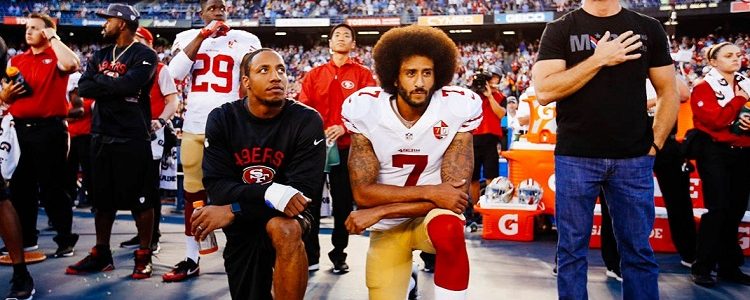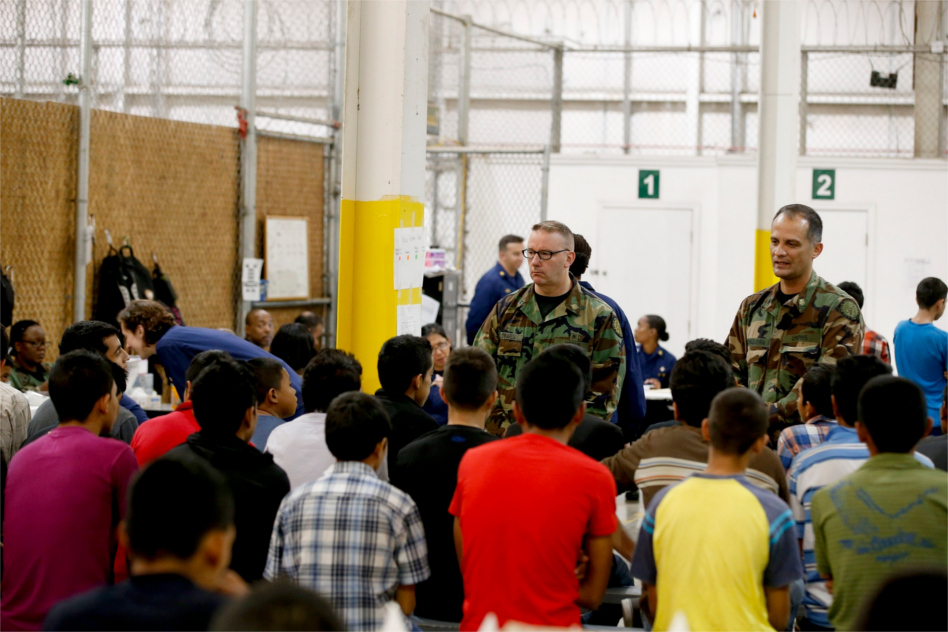Source: Josh Levin, “Colin Kaepernick’s Protest Is Working,” slate.com, Sep. 12, 2016
People who support refusing to stand for the national anthem argue that athletes are justified in using their celebrity status to bring attention to important issues, and that refusing to stand for the national anthem is an appropriate and effective method of peaceful protest. People who disagree argue that football games are an inappropriate place to engage in political protest, and that not standing for the national anthem shows disrespect for the country and those who proudly support it, some with their lives.
Is Kneeling during the National Anthem an Appropriate Form of Protest?
Pro 1
When one believes the United States is not living up to its ideals of freedom, liberty, and justice for all, kneeling during the national anthem is appropriate and justified.
Colin Kaepernick said, “I’m not going to stand up to show pride in a flag for a country that oppresses black people and people of color… To me, this is bigger than football and it would be selfish on my part to look the other way. There are bodies in the street and people getting paid leave and getting away with murder.” Many other athletes have since refused to stand for the national anthem for similar reasons. Denver Broncos linebacker Brandon Marshall, who also has knelt during the national anthem, said, “the message is I’m against social injustice… I’m not against the military or police or America at all.” NASCAR official and Army veteran Kirk Price, who kneeled during the anthem at a June 2020 race, stated, “I fully respect the flag… That’s not what the issue is here. The issue is African Americans being oppressed for so long under the flag… But to be honest with you, I know what the flag stands for and I know about Black people being oppressed because I am one.”
Pro 2
When a national figure such as an NFL player kneels during the national anthem, it shocks people into paying attention and generates conversation.
Many people were shocked and offended when Colin Kaepernick refused to stand for “The Star-Spangled Banner,” and the resulting debate has continued as additional players joined the protest. NFL Commissioner Roger Goodell originally disagreed with those actions, but later praised what he called a movement from protest to progress: “I truly respect our players wanting to speak out and change the community… We want them to use that voice.” Social media has given a voice to strong opinions on both sides, including members of the armed forces who express support Kaepernick’s right to protest by posting under the hashtag #VeteransForKaepernick.
Pro 3
Kneeling during the national anthem is a legal form of peaceful protest, which is a First Amendment right.
President Obama said Kaepernick was “exercising his constitutional right to make a statement. I think there’s a long history of sports figures doing so.” The San Francisco 49ers said in a statement, “In respecting such American principles as freedom of religion and freedom of expression, we recognize the right of an individual to choose and participate, or not, in our celebration of the national anthem.” A letter signed by 35 US veterans stated that “Far from disrespecting our troops, there is no finer form of appreciation for our sacrifice than for Americans to enthusiastically exercise their freedom of speech.”
Con 1
Kneeling during the national anthem shows disrespect for the flag and members of the armed forces.
The national anthem pays respect to the people who have risked their lives, been injured, or died defending the United States. Carole Isham, a great-great-great-granddaughter of the writer of the national anthem (Francis Scott Key) stated that “it just blows my mind that somebody like (Kaepernick) would do what he does to dishonor the flag of this country and the national anthem when we have young men and women overseas fighting for this country, people that have died for this country.” Drew Brees, New Orleans Saints quarterback, supported Kaepernick’s message but disagreed with the delivery: “[I]t’s an oxymoron that you’re sitting down, disrespecting that flag that has given you the freedom to speak out.” Brees reiterated his position on June 3, 2020 in the wake of the George Floyd killing. However, in light of the backlash that followed, Brees retracted his statement. In reaction, on June 5, 2020, President Trump tweeted, “OLD GLORY is to be revered, cherished, and flown high… “We should be standing up straight and tall, ideally with a salute, or a hand on heart. There are other things you can protest, but not our Great American Flag – NO KNEELING!”
Con 2
Kneeling during the national anthem is an ineffective and counterproductive way to promote a cause.
Clemson University football coach Dabo Swinney said in a press conference: “I don’t think it’s good to be a distraction to your team. I don’t think it’s good to use your team as the platform.” President Obama expressed concern that not standing for the national anthem can get in the way of the message: “As a general matter, when it comes to the flag the national anthem and the meaning that holds for our men and women in uniform and those who’ve fought for us — that is a tough thing for them to get past to then hear what his [Kaepernick’s] deeper concerns are.” Malcolm Jenkins, safety for the Philadelphia Eagles, supported Kaepernick’s message but said, “My grandfather served [in the military]. And this is a country that I love. So, me not standing for the national anthem isn’t really going to get me the results that I want.”
Con 3
Kneeling during the national anthem angers many and sows division in our country.
Kaepernick and others who have refused to stand for the national anthem have caused division among their teams, their fans, and across the country. The Santa Clara police union hinted they would boycott providing security at games after Kaepernick revealed his reasons for protesting the national anthem and wore socks depicting pigs in police uniforms. Fans have been burning Kaepernick’s jersey to show their distaste for his actions. One video of a jersey on fire posted on Facebook was captioned, “He says he’s oppressed making $126 million. Well, Colin, here’s my salute to you.”
Some Cleveland Browns fans expressed their dissatisfaction on the team’s Facebook page. One commenter posted, “Pray before or pray after. Taking a knee during the National Anthem these days screams disrespect for our Flag, Our Country and our troops. My son and the entire armed forces deserve better than that.” [22]

Source: Satchel Price, “Cleveland Browns Players Kneel During National Anthem,” sbnation.com, Aug. 22, 2017
On Friday, Sep. 22, 2017, President Donald Trump stated his opposition to NFL players kneeling during the anthem: “Wouldn’t you love to see one of these NFL owners, when somebody disrespects our flag, to say ‘Get that son of a bitch off the field right now. Out! He’s fired. He’s fired!” [23] The statement set off a firestorm on both sides of the debate. Roger Goodell, NFL Commissioner, said of Trump’s comments, “Divisive comments like these demonstrate an unfortunate lack of respect for the NFL, our great game and all of our players, and a failure to understand the overwhelming force for good our clubs and players represent in our communities.” [23]
The controversy continued over the weekend as the President continued to tweet about the issue and others contributed opinions for and against kneeling during the anthem. On Sunday, Sep. 24, in London before the first NFL game played after Trump’s comments, at least two dozen Baltimore Ravens and Jacksonville Jaguars players knelt during the American national anthem, while other players, coaches, and staff locked arms, including Shad Khan, who is the only Pakistani-American Muslim NFL team owner. [24] Throughout the day, some players, coaches, owners, and other staff kneeled or linked arms from every team except the Carolina Panthers. The Pittsburgh Steelers chose to remain in the locker room during the anthem, though offensive tackle and Army Ranger veteran Alejandro Villanueva stood at the entrance to the field alone, for which he has since apologized. [27] Both the Seattle Seahawks and Tennessee Titans teams stayed in their locker rooms before their game, leaving the field mostly empty during the anthem. The Seahawks stated, “As a team, we have decided we will not participate in the national anthem. We will not stand for the injustice that has plagued people of color in this country. Out of love for our country and in honor of the sacrifices made on our behalf, we unite to oppose those that would deny our most basic freedoms.” [25]
The controversy has jumped to other sports as every player on WNBA’s Indiana Fever knelt on Friday, Sep. 22 (though WNBA players have been kneeling for months); Oakland A’s catcher Bruce Maxwell kneeled on Saturday becoming the first MLB player to do so; and Joel Ward, of the NHL’s San Jose Sharks, said he would not rule out kneeling. USA soccer’s Megan Rapinoe knelt during the anthem in 2016, prompting the US Soccer Federation to issue Policy 604-1, ordering all players to stand during the anthem. [28][29][30][31][35]
The country was still debating the issue well into the week, with Trump tweeting throughout, including on Sep. 26: “The NFL has all sort of rules and regulations. The only way out for them is to set a rule that you can’t kneel during our National Anthem!” [26]
On May 23, 2018, the NFL announced that all 32 team owners agreed that all players and staff on the field shall “stand and show respect for the flag and the Anthem” or face “appropriate discipline.” However, all players will no longer be required to be on the field during the anthem and may wait off field or in the locker room. [32][33] The new rules were adopted without input from the players’ union. [33] On July 20, 2018, the NFL and the NFL Players Association (NFLPA) issued a joint statement putting the anthem policy on hold until the two organizations come to an agreement. [34]
During the nationwide Black Lives Matter protests following the death of George Floyd, official league positions on kneeling began to change. On June 5, 2020, NFL Commissioner Roger Goodell stated, “We, the National Football League, condemn racism and the systematic oppression of black people. We, the National Football League, admit we were wrong for not listening to NFL players earlier and encourage all players to speak out and peacefully protest.” [39] Before the June 7, 2020 race, NASCAR lifted the guidelines that all team members must stand during the anthem, allowing NASCAR official Kirk Price to kneel during the anthem. [40] On June 10, 2020, the US Soccer Federation rescinded the league’s requirement that players stand during the Black Lives Matter protests following the death of George Floyd. The US Soccer Federation stated, “It has become clear that this policy was wrong and detracted from the important message of Black Lives Matter.” [35] In the wake of the 2020 killing of George Floyd and the protests that followed, 52% of Americans stated it was “OK for NFL players to kneel during the National Anthem to protest the police killing of African Americans.” [41]

Source: Stephen Douglas, “Indiana Fever Kneel for National Anthem before WNBA Playoff Game,” thebiglead.com, Sep. 21, 2017
Discussion Questions
1.Should professional athletes be allowed to kneel during the national anthem in protest? Why or why not?
2. Should student athletes be allowed to kneel during the national anthem in protest? Why or why not?
3. What forms of protest are acceptable in which venues? Which are not acceptable? Explain your answers.
1. Explore “The Purpose and Power of Protest” with the Anti-Defamation League.
2. Delve into the Albert Einstein Institution’s list, “198 Methods of Nonviolent Action.”
3. Consider Marc A. Thiessen’s opinion that kneeling during the anthem is a protest against America.
4. Push for the position and policies you support by writing US national senators and representatives.
Sources




